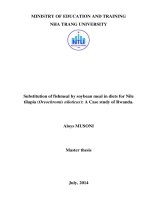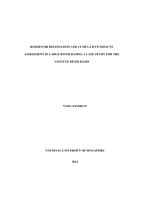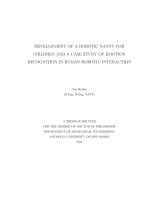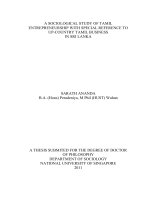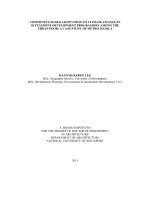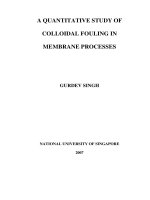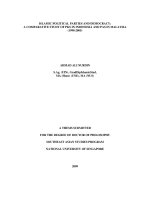A proteomics study of chemically induced cirrhosis in rat liver revealed the mechanism of thioacelamide hepatotoxicity 3
Bạn đang xem bản rút gọn của tài liệu. Xem và tải ngay bản đầy đủ của tài liệu tại đây (20.01 MB, 65 trang )
Chapter 3
Chapter 3
Results
Chapter 3
83
3.1 Histo-pathology of rat liver tissues
Generally, with increasing duration of TAA treatment, the fibrous content in the
livers increased as compared to the controls. For example, after 3 weeks of treatment,
most of the experimental rats had scores of 2s to 3s at ten different fields being analyzed
(Table 3-1) as compared to the scores of 0s and 1s for the corresponding controls. This
shows that with only 3 weeks of TAA treatment, the rat livers had developed increased
deposition of collagen, but septa were still absent or incomplete in the liver samples
(Figure 3-1).
However, after 6 weeks (Table 3-2 and Figure 3-2) and 10 weeks (Table 3-3 and
Figure 3-3) of treatment, most of the ten fields examined in the treated livers had
maximum scores of 4. This means that most of the liver at this stage had developed full-
blown cirrhosis, with increase of collagen and formation of complete septa, some even
with obvious nodularity (marked with “n”), as observed in Figure 3-2 and 3-3.
Collectively, these results show that our approach had successfully generated fibrosis and
cirrhosis in the rat livers. The details of the histo-pathological slides and scores are
illustrated from Table 3-1 and Figure 3-1 onwards.
Chapter 3
84
Table 3-1 Histo-pathological scores at ten different fields for rats treated with TAA for 3
weeks
Rat Serial No.
Histo-pathological scores at ten different fields for rats
after 3 weeks of TAA treatment
SR63 0,0,0,0,0,1,0,0,0,0
SR64 0,0,1,1,0,0,0,1,0,0
SR65 1,0,1,1,1,1,0,1,1,1
SR66 0,1,0,1,1,0,0,0,1,1
SR85 0,0,1,1,0,1,1,1,0,0
CONTROL
SR86 0,1,1,1,0,1,1,1,0,1
SR16 3,3,3,2,3,3,2,3,3,2
SR17 3,3,3,3,3,3,3,3,3,2
SR18 3,3,3,3,3,3,3,3,3,2
SR19 2,3,2,2,3,3,3,2,3,3
SR21 2,2,2,3,2,2,1,2,2,3
EXPERIMENTAL
SR22 4,3,3,3,4,3,3,3,2,3
Chapter 3
85
Figure 3-1 Tissue sections (x20) of r
at livers stained with Mason Trichrome stain for
rat liver tissues treated with TAA for 3 weeks.
3 week control
3 week experimental
Chapter 3
86
Table 3-2 Histo-pathological scores at ten different fields for rats treated with TAA for 6
weeks.
Rat Serial No.
Histo-pathological scores at ten different fields for rats
after 6 weeks of TAA treatment
SR5 0,0,0,0,0,0,1,0,0,1
SR8 1,1,1,1,1,2,1,1,1,1
SR55 0,1,0,0,0,1,0,1,0,1
SR57 0,0,1,1,1,1,0,1,0,0
SR58 0,0,0,0,1,0,0,0,0,1
CONTROL
SR88 1,1,1,0,1,1,1,1,1,0
SR2 4,4,4,4,4,4,4,4,4,4
SR3 4,4,4,4,3,4,4,4,4,4
SR7 4,4,4,4,4,4,4,4,4,4
SR9 4,4,4,4,4,4,4,4,4,4
SR54 4,3,4,4,4,4,4,3,4,4
EXPERIMENTAL
SR56 4,4,4,4,4,4,4,4,4,4
Chapter 3
87
Figure 3-2 Tissue sections (x20) of rat livers stained with Mason Trich
rome stain.
Cirrhotic nodules (n) are present at 6 weeks experimental liver sections. Fibrous tissue is
stained green.
6 week control
6 week experimental
n
Chapter 3
88
Table 3-3 Histo-pathological scores at ten different fields for rats treated with TAA for
10 weeks
Rat Serial No.
Histo-pathological scores at ten different fields for rats
after 10 weeks of TAA treatment
SR79 0,0,0,0,0,0,0,1,0,0
SR80 1,0,0,0,0,0,0,0,0,0
SR81 1,1,0,1,1,1,0,1,0,0
SR82 0,0,0,1,0,0,0,0,0,0
SR83 0,0,1,0,0,1,0,0,0,1
CONTROL
SR84 0,0,1,1,0,1,0,0,0,0
SR67 4,4,4,4,4,4,4,4,4,4
SR73 4,4,3,4,4,4,4,4,4,4
SR74 4,4,4,4,4,4,4,4,4,4
SR75 4,4,4,4,4,4,4,4,4,4
SR77 4,4,4,4,4,4,4,4,4,4
EXPERIMENTAL
SR78 4,4,4,4,4,4,4,4,4,4
Chapter 3
89
Figure 3-3 Tissue sections (x20) of r
at livers stained with Mason Trichrome stain.
Cirrhotic nodules (n) are present at 10
weeks experimental liver sections. Fibrous tissue is
stained green.
10 week control
10 week experimental
n
Chapter 3
90
We performed student’s t test to confirm the differences. At 3 weeks, the mean
fibrosis score of the control animals was 0.483. The corresponding score for the
experimental animals was 2.7, which was significantly higher than its control (p <0.05).
At 6 weeks, the livers of the experimental animals were cirrhotic on macro- and
microscopic examination. The fibrosis score was 3.95 and was significantly higher that
its control, 0.533 (p < 0.05). Similarly, 10 weeks experimental animals had gross
cirrhosis. The mean fibrosis score was 3.98 versus 0.25 in controls (p < 0.05). After 3
weeks of TAA treatment, there was evidence of increased fibrosis but no evidence of
cirrhosis. However, definite cirrhotic nodules were obvious in the 6 and 10 weeks
experimental rat livers (Figures 3-2 and 3-3).
In fibrotic and cirrhotic livers, total collagen is increased up to eight fold, mainly
because of collagen type I deposits (Rojkind et al., 1982) and the primary source of
collagen is the perisinusoidal stellate cells. Following fibrosis and cell deaths,
hepatocellular regeneration occurs with the thickening of liver cell-plates. The
parenchyma expands against the constraining fibrous septa and tends to take up a
spherical shape, forming nodules. Hence, in cirrhosis, the nodularity of the liver is
mostly the result of fibrosis dissecting the parenchyma in small uniform acinar or
subacinar nodules in micronodular types and in lobular and plurilobular large non-
uniform nodules in macronodular forms. Regenerative nodules develop in the midst of
scars but are a late phenomenon.
Chapter 3
91
3.2 2-DE of TAA-treated rat liver tissues
In generating the 2-DE gels, six pairs of control and treated samples were used
for each time point with triplicate gels per sample. Firstly, the “best gels” were visually
analyzed for differentially expressed protein spots. The best gel was the representative
gel chosen from the triplicate gels based on good image resolution and spot sharpness and
it contained the highest number of spots. To avoid ambiguity, only spots that were
prominently different in the 2-DE gels were chosen. Subsequently, representative gels of
all the controls were collectively analyzed for consistent spots. This process was
repeated for the best gels of the treated samples. Then protein spots that were consistent
in at least four out of six pairs were chosen and labeled on a “master gel”. This
methodology is illustrated in figures 3-4 and 3-5.
Visual analysis ensures that the chosen spots were consistent and thus
reproducible in different samples. Besides, overloaded spots tend to be present as
“hollow” or “doughnut” spots after being stained with silver. Software analysis could not
detect and quantify the intensities of these hollow spots and hence visual analysis was
used. After visual inspection, these spots were identified and recorded as “hollow” in
Table 3-4. Finally, PDQuest
®
software was used to confirm the reproducibility of the
spots in all the triplicate gels. At the same time, the spot intensities were determined in
normalized average values. A student’s t test at 5% confidence level was later performed
for each match-set whereby a match-set consisted of all the gels, inclusive of both control
and experimental gels, from each time point.
Chapter 3
92
ONLY CONSISTENT
REGIONS ARE
SELECTED
A*
1*
B*
2*
MASTER GEL FOR
CONTROL GROUP
TREATED
CONTROL
MASTER GEL FOR
TREATED GROUP
Figure 3
-
4
depicts the first part of our approach for image analysis. First, the best gel from
each sample was chosen.
They were represented by A*, B* and 1*, 2*. Then A* was compared visually with 1* for differentially expressed
spots.
This was repeated for B* and 2*. These comparisons were based on the following criteria: i.) Spots we
re of reasonable
sizes and intensities ii.) Only spots that were present/absent or very high in contrast to ver
y low intensity and to avoid
ambiguity, faint or small spots were excluded. Spots that were over-
expressed in any one gel were labeled on that gel
itself. Finally, gels from the same group i.e. A* and B* were compared so that differentially expressed spots that were
reproducible were detected and labeled on a “Master gel”.
Chapter 3
93
PDQuest
®
software
analysis
Sample A: 3 of the
best duplicate gels
MASTER GEL FOR
TREATED GROUP –
AS A GUI
D
E
Sample B: 3 of the
best duplicate gels
Sample 1: 3 of the
best duplicate gels
MASTER GEL FOR
CONTROL GROUP –
AS A
GUI
D
E
Sample 2: 3 of the
best duplicate gels
Figure 3
-
5
depicts the second part of our approach for image analysis. First,
with the help of a “Master gel” from visual
analysis (Figure 3-4), the reproducibility of differentially expressed spots of 3 of the best gels for each sample
was
confirmed. This was performed with PDQuest
®
, software for image analysis, which collectively analyzed the intensities
of
all the selected spots at the same time thus providing statistically-significant spot data.
Chapter 3
94
3.2.1 Visual analysis results
Our preliminary visual analysis yielded several regions of interest that was
further analyzed with PQQuest
®
later. These regions are displayed in each representative
gels as the following images.
3.2.1.1 Representative 2-D gels for 3 week control samples
210.0
116
.0
97.4
66.0
45.0
31.0
21.5
pI
3
10
Figure 3
-
6
shows a best control gel from the 3 week group. Differentiall
y
expressed protein spots of interest are circled. At the right are
molecular
weight markers labeled in kDa unit.
3
10
pI
kDa
Chapter 3
95
3.2.1.2 Representative 2-D gels for TAA-treated samples (3-week)
210.0
116
.0
97.4
66.0
45.0
31.0
21.5
pI
3
10
Figure 3
-
7
shows a best experimental
gel from the 3 week group.
Differentially expressed protein spots of interest are circled. At the right
are
molecular weight markers labeled in kDa unit.
3
10
pI
kDa
Chapter 3
96
3.2.1.3 Representative 2-D gels for 6 week control samples
210.0
1
16
.0
97.4
66
.0
45.0
31.0
21.5
pI
3
10
Figure 3
-
8
shows a best control gel from the 6 week group. Dif
ferentially expressed
protein spots of interest are circled. At the right are molecular weight markers
labeled in kDa unit.
3
10
pI
kDa
Chapter 3
97
3.2.1.4 Representative 2-D gels for TAA-treated samples (6-week)
Figure 3
-
9
shows a best experimental gel from the 6
week group.
Differentially expressed protein spots of interest are circled. At the righ
t are
molecular weight markers labeled in kDa unit.
3
10
pI
kDa
210.0
116.0
97.4
66.0
45.0
31.0
21.5
Chapter 3
98
3.2.1.5 Representative 2-D gels for 10 week control samples
210
.0
116
.0
97.4
66.0
45.0
31.
0
21.5
pI
3
10
Figure 3
-
10
shows a best control gel from the 10 week group. Di
fferentially
expressed protein spots of interest are circled. At the right are
molecular
weight markers labeled in kDa unit.
3
10
pI
kDa
Chapter 3
99
3.2.1.6 Representative 2-D gels for TAA-treated samples (10-week)
210
.0
1
16
.0
97.4
66.0
45.0
31.0
21.5
pI
3
10
3
10
pI
Figure 3
-
11
shows a best experimental gel from the 10 week group. Di
fferentially
expressed protein spots of interest are circled. At the right are
molecular weight
markers labeled in kDa unit.
kDa
Chapter 3
100
3.2.2 PDQuest
®
software analysis
A further analysis of the selected spots by PDQuest
®
yielded normalized data
called spot quantity that reflects the total intensity of a defined spot. This information
was calculated with the following formula:
Spot height is the peak of the Gaussian representation of the spot which is measured in
optical densities (O.D.s). σ
x
is the standard deviation of the Gaussian distribution of the
spot in the direction of the x axis, and σ
y
is the standard deviation in the direction of the y
axis.
These data can provide quantitative data for each spot within a group of gels and
thus level of up- or down-regulation can be estimated based on the ratio of two groups of
gels. These data are represented as folds of changes in Table 3-4.
3.3 Identification of protein spots
To identify the differentially expressed protein spots, these spots were excised
and trypsinized before being analyzed by mass spectrometry. The methods are described
in Chapter 2.
Spot quantity = Spot height * π * σ
x
* σ
y
Chapter 3
101
3.3.1 Excision of spots of interest from CONTROL gels
A total of 41 spots were excised for identification. These spots were down-
regulated in the experimental animals as illustrated in Figure 3-12.
3.3.2 Excision of spots of interest from EXPERIMENTAL gels
A total of 24 spots were excised for identification. These spots were up-
regulated in the experimental animals as illustrated in Figure 3-13.
Chapter 3
102
3.3.3 Protein spots excised from CONTROL gels
Figure 3
-
12
depicts a representative CONTROL gel with
spots of interest labeled with numbers.
These spots were subsequently excised, trypsinzied and analyzed wi
th mass spectrometry. Table
3-4 shows a list of protein identities generated from these spots.
Chapter 3
103
3.3.4 Protein spots excised from EXPERIMENTAL gels
Figure 3
-
13
depicts a representative EXPERIMENTAL gel with spots of interest labeled
with
numbers. These spots were subsequently excised, trypsinzied and analyzed wi
th mass
spectrometry. Table 3-4 shows a list of protein identities generated from these spots.
Chapter 3
104
3.4 Compiled list of differentially-expressed proteins
Table 3-4 shows a compiled list of protein spots that underwent quantitative
changes after TAA treatment. The superscript (a.) denotes the accession numbers of
proteins derived from Swiss-Prot and NCBI non-redundant databases (*) while (b.)
protein coverage was calculated based on the percentage of amino acids residues covered
in a particular protein by the matched peptides. (c.) Values for experimental pI and
molecular weight were derived from gel images with software written in-house. Finally
(d.) is the ratios of differential expression derived from the normalized average optical
densities, provided by PD-Quest®. A “+” sign in this table indicates the up-regulation of
the corresponding protein in the TAA-treated samples while a “-” sign denotes down-
regulation in the TAA-treated samples. “#” represents subcellular localization of protein
as predicted with PSORT ( Hollow (C) indicates that the spot
was present as an overloaded, hollow spot in the control gels but not in the experimental
gels. The reverse is true for Hollow (E). While “SAT” indicates that the spot was
saturated. To ensure the confidence of the “fit”, MOWSE score was assigned for each
possible protein identified. The MOWSE score reported by MS-Fit was based on the
scoring system described by Pappin et al. (Pappin et al, 1993).
Chapter 3
105
No.
Accession No.
a
/
Protein Name
MOWSE/
Matched
Peptides/
Theoretical
MW/pI/
Protein Coverage
b
/
Sequence Covered
Experimental
MW x 10
-3
/pI
c
/
subcellular
localization
3-week
Diff. exp.
d
6-week
Diff. exp.
d
10-week
Diff. exp.
d
1.
P15650/ Acyl-CoA
dehydrogenase, long-chain
specific, (RAT)
9.600e+003/
5(25)/
47873/7.6
16%
52-61 (R)IFSSEHDIFR(E)
67-81 (K)FFQEEVIPYHEEWEK(A)
166-185 (K)CIGAIAMTEPGAGSDLQGVR(T)
255-267 (K)AQDTAELFFEDVR(L)
280-292 (K)GFYYLMQELPQER(L)
48.3/ 6.38
Mitochondrial matrix
-2.45 -2.18 -1.73
2.
P14604 /enoyl-CoA
hydratase (RAT)
3.073e+007 /
12(34)/ 38%/
31517/ 8.4
38%
44-56 (K)NSSVGLIQLNRPK(A)
107-115 (R)TFQDCYSGK(F)
116-125 (K)FLSHWDHITR(I)
158-178 (K)AQFGQPEILLGTIPGAGGTQR(L)
186-197 (K)SLAMEMVLTGDR(I)
212-228 (K)IFPVETLVEEAIQCAEK(I)
242-257 (K)ESVNAAFEMTLTEGNK(L)
242-260 (K)ESVNAAFEMTLTEGNKLEK(K)
262-272 (K)LFYSTFATDDR(R)
31.0/ 6.3
Mitochondrial matrix
-3.87 -2.65 -2.37
3.
P14604 /enoyl-CoA
hydratase (RAT)
1.66e+003/
4 (24)/
31517/ 8.4
19%
44-56 (K)NSSVGLIQLNRPK(A)
116-125 (K)FLSHWDHITR(I)
158-178 (K)AQFGQPEILLGTIPGAGGTQR(L)
186-197 (K)SLAMEMVLTGDR(I)
31.0/ 6.55
Mitochondrial matrix
-1.32
Hollow/
4388.9+40.2
Hollow/
755.4+70.3
Table 3-4 Differentially-expressed proteins
Chapter 3
106
No.
Accession No.
a
/
Protein Name
MOWSE/
Matched
Peptides/
Theoretical
MW/pI/
Protein Coverage
b
/
Sequence Covered
Experimental
MW x 10
-3
/pI
c
/
subcellular
localization
3-week
Diff. exp.
d
6-week
Diff. exp.
d
10-week
Diff. exp.
d
4.
P14604 /enoyl-CoA
hydratase (RAT)
1.471e+007/
10(41)/
31517/ 8.4
39%
44-56 (K)NSSVGLIQLNRPK(A)
107-115 (R)TFQDCYSGK(F)
116-125 (K)FLSHWDHITR(I)
158-178 (K)AQFGQPEILLGTIPGAGGTQR(L)
186-197 (K)SLAMEMVLTGDR(I)
186-197 (K)SLAMEMVLTGDR(I) 1Met-ox
212-228 (K)IFPVETLVEEAIQCAEK(I)
242-260 (K)ESVNAAFEMTLTEGNKLEK(K)
262-272 (K)LFYSTFATDDR(R)
31.0/ 6.8
Mitochondrial matrix
-1.36
Hollow/
2731.8+51.0
Hollow/
2272.2+59.4
5.
P14141/ Carbonic
anhydrase III (RAT)
2.588e+004/
7(23)/
29432/ 6.9
71%
25-36 (K)GDNQSPIELHTK(D)
40-57 (R)HDPSLQPWSVSYDPGSAK(T)
68-76 (R)VVFDDTFDR(S)
81-89 (R)GGPLSGPYR(L)
114-126 (K)YAAELHLVHWNPK(Y)
172-188 (K)EAPFNHFDPSCLFPACR(D)
31.0/ 7.1
Cytoplasmic
No Significant
Difference
Hollow/
1963.7+68.8
Hollow/
1152.2+72.8
6.
P14141/ Carbonic
anhydrase III (RAT)
3.89e+004/
6(17)/
29431.6/ 6.89
30%
68-76 (R)VVFDDTFDR (S)
81-89 (R) GGPLSGPYR (L)
114-126 (K)YAAELHLVHWNPK (Y)
127-135 (K) YNTFGEALK (Q)
136-148 (K)QPDGIAVVGIFLK (I)
152-165 (R)EKGEFQILLDALDK (I)
154-165 (K)GEFQILLDALDK (I)
31.0/ 7.33
Cytoplasmic
-2.15
Hollow/
844.5+71.9
Hollow/
693.2+68.2

